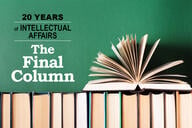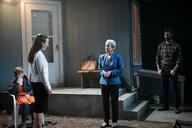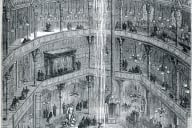You have /5 articles left.
Sign up for a free account or log in.
Over the past couple of years, Inside Higher Ed has had someone on the floor of whichever cavernous convention center is home to Book Expo America, the trade show for the publishing industry that is held after Memorial Day weekend. The scale of this event is difficult take in, let alone describe. You stand in the aisles and hear an ocean of money roaring through the auditorium. Even the most prestigious and powerful university presses -- the ones that dominate the exhibit halls at major scholarly conferences -- tend to look rather modest at Book Expo. Theirs are the booths without stacks of free books or celebrity appearances. Nobody publishing with Harvard or Princeton will dress in an oversized novelty costume. If you propose the idea, they will tell you no.
BEA ‘08 was held in Los Angeles this year. Given the pace at which fuel prices keep increasing, it was difficult to be sure of affording a cab to the airport, let alone any longer trip -- so the best we can do for coverage this time is to point you to a compilation of reports. In a few weeks, I plan to strap myself to the underside of an 18-wheel truck in order to attend the convention of the Association of American University Presses, in Montreal. But for now, here is a brief dispatch from a recent tour of the university press catalogs for the fall -- a first look at the books that might break out to attract a nonspecialist audience.
One word that comes to mind to characterize the new lists is “recessionary.” Nothing looks like a potential blockbuster. No "exciting new trend in scholarship" is being promoted like a subprime mortgage that's too tempting to resist. There seems to be a spirit of trying to get through the season in one piece.
Two or three years ago, you could scan a catalog and tell which book someone at the press thought might lead to five minutes of smart banter on "The Daily Show" or "The Colbert Report." (Conversation with the publicists would often confirm one's hunch about such daydreams.) But those days are gone, at least for a while. Booksellers were noticing a slowdown well before the housing-market collapse. University presses, having barely adapted to the effects of shrinking library sales, can scarcely afford to risk issuing a title in a (relatively) large print run only to have nearly all of it returned by the stores.
Expectations have diminished. The most obvious sign of this can be found in how university presses are going to capitalize on the fall presidential campaign.
They aren’t.
The one exception is What’s Wrong with Obamamania? Black America, Black Leadership, and the Death of Political Imagination by Ricky L. Jones, appearing this month from State University of New York Press. It treats the emergence of Barack Obama as the culmination of “disturbing shifts in

black leadership since the 1960s,” according to the SUNY catalog, painting “a picture of lowered expectations, cynicism, and nihilism that should make us all pause.” An early review from Publishers Weekly praises Jones -- an associate professor of pan-African studies at the University of Louisville -- for providing “a level of racial analysis and exploration that is almost entirely absent in the mainstream media.”
No comparable critical insights into John McCain are being offered by scholarly presses. But a couple of titles appearing in November explore the inner workings of the conservative policy elite. Ann Southworth’s Lawyers of the Right: Professionalizing the Conservative Coalition (University of Chicago Press) looks at the alliances and tensions among legal advocates for three factions within the Republican Party: social conservatives, libertarians, and business interests. Timothy J. Sullivan’s New York State and the Rise of Modern Conservatism: Redrawing the Party Lines (SUNY) looks at ideological struggles within the party in the 1960s and ‘70s. It is a chapter in the prehistory of the “Reagan Revolution” -- to which John McCain is now writing, perhaps, the decisive postscript.
Other titles are not so much wonkish as meta-wonkish.That term certainly applies to Murray Weidenbaum’s The Competition of Ideas: The World of the Washington Think Tanks, appearing from Transaction in September. Weidenbaum, an inside-the-Beltway policy intellectual, criticizes the failures of management and “quality control” within the policy shops.

Lawrence Davidson’s Foreign Policy, Inc.: Privatizing America’s National Interest, to be published by the University of Kentucky Press, will argue that well-organized special interests play a very large role in how American policy is formulated and implemented. One sees why this book is scheduled for January. Otherwise the tsunami of public indignation at this revelation could well disrupt the election.
Less shocking may be The Private Abuse of the Public Interest: Market Myths and Policy Muddles, by Lawrence D. Brown and Lawrence R. Jacobs, coming from the University of Chicago Press in October. The two Lawrences maintain that “conservative efforts to expand markets and shrink government often have the ironic effect of expanding government’s reach by creating problems that force legislators to enact new rules and regulations.” And mind you, that’s even without a war.
Speaking of which.... University presses have several books about the Iraq War in print or on the way. Five years in, and counting, there is a lot of it to study.
The title most likely to get significant attention from the press is probably Baghdad at Sunrise: A Brigade Commander’s War in Iraq by Peter R. Mansoor, a recently retired U.S. Army colonel who was a commander on the ground during the first year of the occupation. Forthcoming from Yale University Press in September, it arrives with a blurb from Gen. David Petraeus calling the book “a must read for soldiers, scholars, and policymakers alike.”
The Gods of Diyala: Transfer of Command in Iraq, scheduled for September by Texas A&M Press, might find readers even without a four-star endorsement. The authors, Caleb S. Cage and Gregory S. Tomlin, were deployed as part of a field artillery task force in March 2004 and remained there through the first post-Saddam election in early 2006. Their grunts'-eye-view of this chapter in military history has a potential audience among both members of military families and what I guess you would have to call "war buffs," strange as that expression seems in this context.
A&M will also publish Intelligence and National Security Policymaking in Iraq: British and American Perspectives -- a collection of historical documents and insider accounts from both sides of the pond, edited by James P. Pfiffner and Mark Phythian. The press may have the fast track on future such collections, given that Robert Gates, the Secretary of Defense, is a former president of A&M.
Finally, there is Aaron Glantz’s The War Comes Home: Washington’s Battle Against America’s Veterans, due out in January. The University of California Press catalog describes it as “the first book to systematically document the U.S. government’s neglect of soldiers returning from Iraq and Afghanistan.”
Every so often someone will notice that books on religion are selling well and deduce that the frustrations of modern life are creating a “return to spirituality.” Well, no. Lots of people want to read about religion, and always have. Questions of ultimate significance tend to stick around. What comes and goes is just the secular world’s attention to that fact. A few forthcoming titles from university presses are addressed to the concerns of believers -- and also to those living the God-free life.
Next year marks the 50th anniversary of John Paul XXIII’s announcement of the second Vatican Council -- the most transformational moment in Catholic history since Martin Luther got annoyed. The implications of Vatican II still generate a great deal of passionate discussion, not least among certain of my in-laws. From observing that particular focus group, I'd say that John W. O’Malley’s What Happened at Vatican II will be a big event when Harvard University Press publishes it in September. In addition to narrating the

history of the arguments and decisions made within the council, O'Malley will offer “a new set of interpretive categories for understanding the council’s dynamics,” it seems, “categories that move beyond the tired ‘progressive’ and ‘conservative’ labels."
In October, Harvard is also publishing Seven Deadly Sins: A Very Partial List, by Aviad Kleinberg, who is described by the copywriters as “one of the most prominent public intellectuals in Israel." It sounds as if the gist of Kleinberg’s argument may be that their deadliness is much overstated. “We sin a little just to live on,” as Goethe said.
Two psychology professors, Ralph W. Hood Jr. and W. Paul Williamson, present what may be “the most in-depth, comprehensive study of snake handling to date,” as the University of California Press says in describing their September book Them That Believe: The Power and Meaning of the Christian Serpent-Handling Tradition. The authors spent 15 years touring churches in the south where believers -- filled with the power of the Holy Ghost -- practice a literal interpretation of certain passages in the gospels that most Christians prefer to construe metaphorically.
Whether by coincidence or divine providence, Yale University Press will publish James H. Charlesworth’s The Good and Evil Serpent: How a Universal Symbol Became Christianized, in November. And the following month, Yale will issue David Hempton’s Evangelical Disenchantment: Nine Portraits of Faith and Doubt -- a study of prominent figures who broke with evangelical Christianity, among them George Eliot, Vincent van Gogh, and James Baldwin.
Phil Zuckerman’s Society Without God: What the Least Religious Nations Can Tell Us About Contentment ought to be good for a few angry sermons once New York University releases it in October. Based on intensive sociological research in Denmark and Sweden (where open professions of faith are as rare as they are obligatory in some parts of the United States), Zuckerman found high levels of happiness, low levels of corruption, and a willingness to face life without worrying that much about what happens once you are dead. “Society without God is not only possible,” he concludes, “but it can be quite civil and pleasant.”
If it leaves you unfulfilled, however, you might want to read Mind and Life: Discussions with the Dalai Lama on the Nature of Reality, which Columbia University Press is issuing in November. There’s also Opening the Qur’an: Introducing Islam’s Holy Book by Walter H. Wagner. It is due in October from the University of Notre Dame Press, which is evidently trailblazing new paths in ecumenicalism.
It will be a good season for books about sports -- starting in September with Dave Zirin’s overview of A People’s History of Sports in the United States, appearing in the series that Howard Zinn edits for the New Press. (As of five years ago, Zinn’s own People’s History of the United States, published in 1980, was selling over 125,000 copies a year, not all of them for classroom use.) Zirin’s book offers “an alternative history of the United States as seen through the games its people played,” as the publisher puts it.

In October, Indiana University Press revisits the history of its parent institution with Getting Open: The Unknown Story of Bill Garrett and the Integration of College Basketball, by Tom Graham and Rachel Graham Cody. When Garrett joined the college basketball program at Indiana University in 1947, it desegregated the Big Ten. Also of hoop-ological interest is Jump for Joy: Jazz, Basketball, and Black Culture in 1930s America, by Gena Caponi-Tabery, which has just been published by the University of Massachusetts Press.
All due credit to other academic publishers, of course, but the University of Nebraska Press has shown by far the strongest commitment to publishing serious books on sports, over the years. To keep this column within manageable bounds, two such titles in the fall catalog are especially worth noting.
One is an anthology, The Global Game: Writers on Soccer, due in November. Among its 60 or so contributors are Gunter Grass, Ted Hughes, Mario Vargas Llosa, Charles Simic, Elvis Costello, and Zapatista leader Subcomandante Marcos.The other book is David Scott’s The Art and Aesthetics of Boxing, appearing in January. “Divided into three parts,” the catalog says, it “moves from a consideration of the evolution and intrinsic aesthetics of boxing to the responses to the sport by cubist and futurist painters and sculptors, installation artists, poster designers, photographers, and, finally surrealist poets.”
It sounds very thorough. But I can’t help wondering how you could improve upon the “Deep Thoughts” of Jack Handey, who once wrote: “To me, boxing is like ballet, except there’s no music, no choreography, and the dancers hit each other.”
We'll continue this look at this fall's offerings from university presses in a second column this month.
In the meantime, a brief note to any publisher who isn't sending catalogs and review copies for consideration by Intellectual Affairs: Seriously, you don't want to reach an audience of hundreds of thousands of professors, administrators, graduate students, and people who otherwise read a lot of books?
Go figure! But if you change your mind, just send things to my attention at the address given here.




